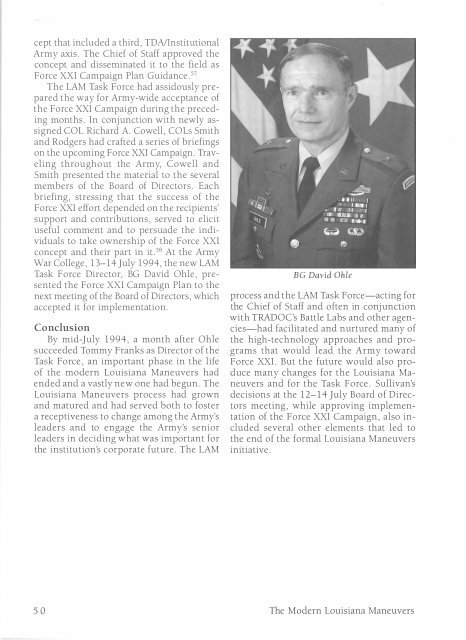The Modern Louisiana Maneuvers - US Army Center Of Military History
The Modern Louisiana Maneuvers - US Army Center Of Military History
The Modern Louisiana Maneuvers - US Army Center Of Military History
Create successful ePaper yourself
Turn your PDF publications into a flip-book with our unique Google optimized e-Paper software.
cept that included a third, TDNInstitutional<br />
<strong>Army</strong> axis. <strong>The</strong> Chief of Staff approved the<br />
concept and disseminated it to the field as<br />
Force XXI Campaign Plan Guidance 57<br />
<strong>The</strong> LAM Task Force had assidously prepared<br />
the way for <strong>Army</strong>-wide acceptance of<br />
the Force XXI Campaign during the preceding<br />
months. In conjunction with newly assigned<br />
COL Richard A. Cowell, COLs Smith<br />
and Rodgers had crafted a series of briefings<br />
on the upcoming Force XXI Campaign. Traveling<br />
throughout the <strong>Army</strong>, Cowell and<br />
Smith presented the material to the several<br />
members of the Board of Directors. Each<br />
briefing, stressing that the success of the<br />
Force XXI effort depended on the recipients'<br />
support and contributions, served to elicit<br />
useful comment and to persuade the individuals<br />
to take ownership of the Force XXI<br />
concept and their part in it.58 At the <strong>Army</strong><br />
War College, 13-14 July 1994, the new LAM<br />
Task Force Director, BG David Ohle, presented<br />
the Force XXI Campaign Plan to the<br />
next meeting of the Board of Directors, which<br />
accepted it for implementation.<br />
Conclusion<br />
By mid-July 1994, a month after Ohle<br />
succeeded Tommy Franks as Director of the<br />
Task Force, an important phase in the life<br />
of the modern <strong>Louisiana</strong> <strong>Maneuvers</strong> had<br />
ended and a vastly new one had begun. <strong>The</strong><br />
<strong>Louisiana</strong> <strong>Maneuvers</strong> process had grown<br />
and matured and had served both to foster<br />
a receptiveness to change among the <strong>Army</strong>'s<br />
leaders and to engage the <strong>Army</strong>'s senior<br />
leaders in deciding what was important for<br />
the institution's corporate future. <strong>The</strong> LAM<br />
50<br />
BG David Ohle<br />
process and the LAM Task Force-acting for<br />
the Chief of Staff and often in conjunction<br />
with TRADOC's Battle Labs and other agencies-had<br />
facilitated and nurtured many of<br />
the high-technology approaches and programs<br />
that would lead the <strong>Army</strong> toward<br />
Force XXI. But the future would also produce<br />
many changes for the <strong>Louisiana</strong> <strong>Maneuvers</strong><br />
and for the Task Force. Sullivan's<br />
decisions at the 12-14 July Board of Directors<br />
meeting, while approving implementation<br />
of the Force XXI Campaign, also included<br />
several other elements that led to<br />
the end of the formal <strong>Louisiana</strong> <strong>Maneuvers</strong><br />
ini tia ti ve.<br />
<strong>The</strong> <strong>Modern</strong> <strong>Louisiana</strong> <strong>Maneuvers</strong>
















